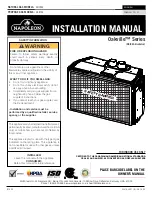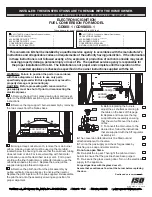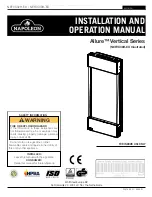
19
Majestic • MARQ42STIN Owner Manual • 2272-981 Rev. L • 12/20
5
5
Frequently Asked Questions and Troubleshooting
A. Frequently Asked Questions - Appliance
ISSUE
SOLUTIONS
Condensation on the glass
This is a result of gas combustion and temperature variations. Prior to appliance being turned
on, the inside of the glass has cooled below the dew point producing a byproduct of combus-
tion: water in the form of condensation. As the fireplace glass warms, the condensation will
disappear.
In the summer, the inside of your fireplace contains hot humid air from outdoors. When the air
from outdoors contacts glass cooled below the dew point by your air conditioning, moisture in
that air will condense.
Blue flames
This is a result of normal operation and the flames will begin to yellow as the fireplace is
allowed to burn for 20 to 40 minutes.
Erratic flames
Verify that the glass assembly is correctly installed and that all four glass latches are engaged
over the four tabs on the glass frame.
Vent baffle/flue restrictor may be needed when long vertical vent runs are used. Refer to
Installation Manual, Section 4: Venting.
Odor from fireplace
When first operated, this fireplace may release an odor for the first several hours. This is caused
by the curing of the paint and the burning off of any oils remaining from manufacturing. Odor may
also be released from finishing materials and adhesives used around the fireplace.
Film on the glass
This is a normal result of the curing process of the paint and logs. Glass should be cleaned
within 3 to 4 hours of initial burning to remove deposits left by oils from the manufacturing pro-
cess. A non-abrasive cleaner such as gas fireplace glass cleaner may be necessary. Contact
your dealer.
Metallic noise
Noise is caused by metal expanding and contracting as it heats up and cools down, similar to
the sound produced by a furnace or heating duct. This noise does not affect the operation or
longevity of the fireplace.
Is it normal to see the pilot flame burn
continually?
In an intermittent pilot ignition system (IPI), the pilot flame should turn off when appliance is
turned off. Some optional control systems available with IPI models may allow pilot flame to
remain lit. In a standing pilot system the pilot will always stay on.
Teco-Sil
There may be some “cracking” noise coming from the fireplace during the first few heating
and cooling cycles. This noise is associated with settling rock and some minor cracking of
larger pieces of rock. This will lessen over time as the Teco-Sil is conditioned to the heating
and cooling temperature changes.
Power Outages
(battery backup)
This appliance can be operated on battery power in the event of a power outage. To access
the battery pack, the decorative barrier front, mesh and glass assembly must be removed.
Refer to Section 3 for more details.
Surfaces above and around the appli-
ance feel hot to the touch.
No action necessary. This appliance ships with a non-combustible material attached. See
Section 3. Specifications of the attached non-combustible material are listed in the Install
-
er’s Manual for this appliance.










































